2010 BMW 335I CONVERTIBLE tire size
[x] Cancel search: tire sizePage 90 of 266
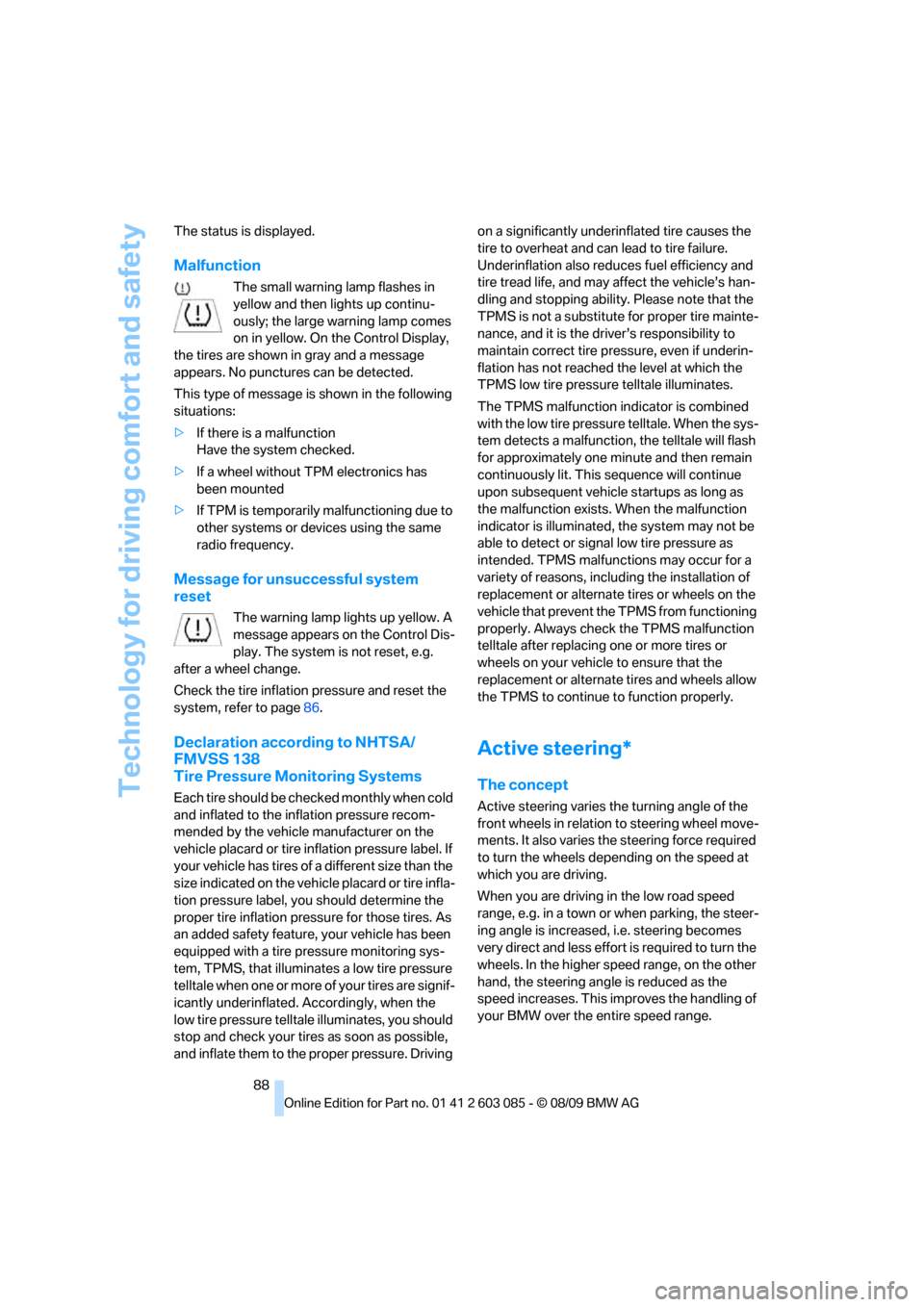
Technology for driving comfort and safety
88 The status is displayed.
Malfunction
The small warning lamp flashes in
yellow and then lights up continu-
ously; the large warning lamp comes
on in yellow. On the Control Display,
the tires are shown in gray and a message
appears. No punctures can be detected.
This type of message is shown in the following
situations:
>If there is a malfunction
Have the system checked.
>If a wheel without TPM electronics has
been mounted
>If TPM is temporarily malfunctioning due to
other systems or devices using the same
radio frequency.
Message for unsuccessful system
reset
The warning lamp lights up yellow. A
message appears on the Control Dis-
play. The system is not reset, e.g.
after a wheel change.
Check the tire inflation pressure and reset the
system, refer to page86.
Declaration according to NHTSA/
FMVSS 138
Tire Pressure Monitoring Systems
Each tire should be checked monthly when cold
and inflated to the inflation pressure recom-
mended by the vehicle manufacturer on the
vehicle placard or tire inflation pressure label. If
your vehicle has tires of a different size than the
size indicated on the vehicle placard or tire infla-
tion pressure label, you should determine the
proper tire inflation pressure for those tires. As
an added safety feature, your vehicle has been
equipped with a tire pressure monitoring sys-
tem, TPMS, that illuminates a low tire pressure
telltale when one or more of your tires are signif-
icantly underinflated. Accordingly, when the
low tire pressure telltale illuminates, you should
stop and check your tires as soon as possible,
and inflate them to the proper pressure. Driving on a significantly underinflated tire causes the
tire to overheat and can lead to tire failure.
Underinflation also reduces fuel efficiency and
tire tread life, and may affect the vehicle’s han-
dling and stopping ability. Please note that the
TPMS is not a substitute for proper tire mainte-
nance, and it is the driver’s responsibility to
maintain correct tire pressure, even if underin-
flation has not reached the level at which the
TPMS low tire pressure telltale illuminates.
The TPMS malfunction indicator is combined
with the low tire pressure telltale. When the sys-
tem detects a malfunction, the telltale will flash
for approximately one minute and then remain
continuously lit. This sequence will continue
upon subsequent vehicle startups as long as
the malfunction exists. When the malfunction
indicator is illuminated, the system may not be
able to detect or signal low tire pressure as
intended. TPMS malfunctions may occur for a
variety of reasons, including the installation of
replacement or alternate tires or wheels on the
vehicle that prevent the TPMS from functioning
properly. Always check the TPMS malfunction
telltale after replacing one or more tires or
wheels on your vehicle to ensure that the
replacement or alternate tires and wheels allow
the TPMS to continue to function properly.
Active steering*
The concept
Active steering varies the turning angle of the
front wheels in relation to steering wheel move-
ments. It also varies the steering force required
to turn the wheels depending on the speed at
which you are driving.
When you are driving in the low road speed
range, e.g. in a town or when parking, the steer-
ing angle is increased, i.e. steering becomes
very direct and less effort is required to turn the
wheels. In the higher speed range, on the other
hand, the steering angle is reduced as the
speed increases. This improves the handling of
your BMW over the entire speed range.
Page 93 of 266
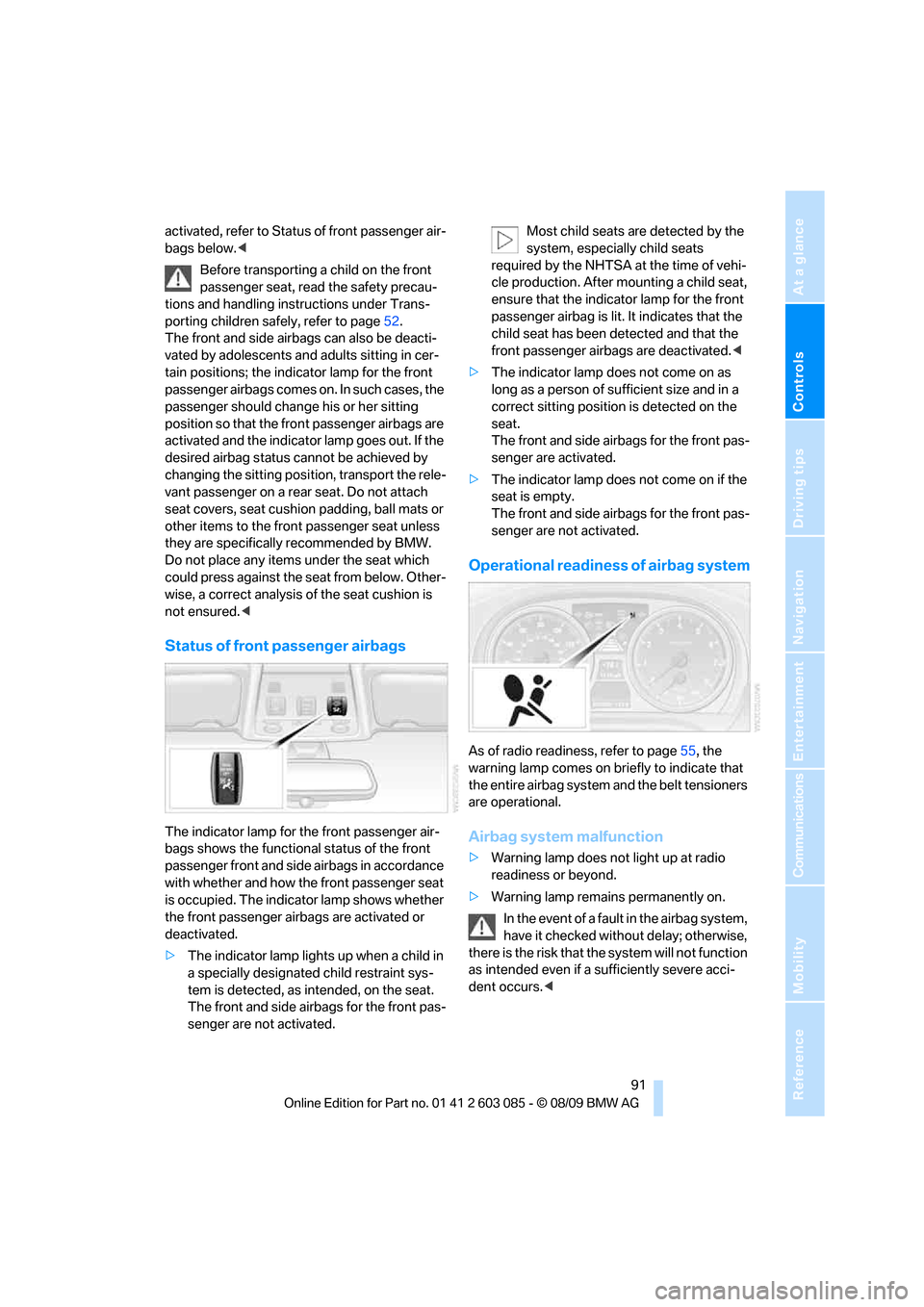
Controls
91Reference
At a glance
Driving tips
Communications
Navigation
Entertainment
Mobility
activated, refer to Status of front passenger air-
bags below.<
Before transporting a child on the front
passenger seat, read the safety precau-
tions and handling instructions under Trans-
porting children safely, refer to page52.
The front and side airbags can also be deacti-
vated by adolescents and adults sitting in cer-
tain positions; the indicator lamp for the front
passenger airbags comes on. In such cases, the
passenger should change his or her sitting
position so that the front passenger airbags are
activated and the indicator lamp goes out. If the
desired airbag status cannot be achieved by
changing the sitting position, transport the rele-
vant passenger on a rear seat. Do not attach
seat covers, seat cushion padding, ball mats or
other items to the front passenger seat unless
they are specifically recommended by BMW.
Do not place any items under the seat which
could press against the seat from below. Other-
wise, a correct analysis of the seat cushion is
not ensured.<
Status of front passenger airbags
The indicator lamp for the front passenger air-
bags shows the functional status of the front
passenger front and side airbags in accordance
with whether and how the front passenger seat
is occupied. The indicator lamp shows whether
the front passenger airbags are activated or
deactivated.
>The indicator lamp lights up when a child in
a specially designated child restraint sys-
tem is detected, as intended, on the seat.
The front and side airbags for the front pas-
senger are not activated.Most child seats are detected by the
system, especially child seats
required by the NHTSA at the time of vehi-
cle production. After mounting a child seat,
ensure that the indicator lamp for the front
passenger airbag is lit. It indicates that the
child seat has been detected and that the
front passenger airbags are deactivated.<
>The indicator lamp does not come on as
long as a person of sufficient size and in a
correct sitting position is detected on the
seat.
The front and side airbags for the front pas-
senger are activated.
>The indicator lamp does not come on if the
seat is empty.
The front and side airbags for the front pas-
senger are not activated.
Operational readiness of airbag system
As of radio readiness, refer to page55, the
warning lamp comes on briefly to indicate that
the entire airbag system and the belt tensioners
are operational.
Airbag system malfunction
>Warning lamp does not light up at radio
readiness or beyond.
>Warning lamp remains permanently on.
In the event of a fault in the airbag system,
have it checked without delay; otherwise,
there is the risk that the system will not function
as intended even if a sufficiently severe acci-
dent occurs.<
Page 202 of 266

Wheels and tires
200
Wheels and tires
Tire inflation pressures
Information for your safety
It is not merely the tires' service life, but also
driving comfort and, to a great extent, driving
safety that depend on the condition of the tires
and the maintenance of the specified tire pres-
sure.
Check the tire inflation pressure regularly
and correct it, if necessary: at least twice a
month and before starting long trips. If you fail
to observe this precaution you may be driving
on tires with incorrect tire pressures, a condi-
tion that can not only compromise your vehi-
cle's driving stability, but also lead to tire dam-
age and the risk of an accident. Do not drive
with deflated, i.e. flat tires, except when using
run-flat tires. A flat tire will seriously impair your
vehicle's handling and braking response.
Attempts to drive on a flat tire can lead to loss of
control over the vehicle.<
Checking pressure
Only check tire inflation pressure when the
tires are cold. This means after a maximum of
1.25 miles/2 km driving or when the vehicle has
been parked for at least 2 hours. When tires are
warm, the tire inflation pressure is higher.
After correcting the tire inflation pressure,
reset the Tire Pressure Monitor, refer to
page86, or reinitialize the Flat Tire Monitor,
refer to page85.<
Inflation pressure specifications
The tables below provide all the correct inflation
pressures for the specified tire sizes at ambient
temperature.
The inflation pressures apply to the tire
sizes approved and tire brands recom-
mended by BMW; a list of these is available
from your BMW center.<
For correct identification of the right tire infla-
tion pressures, observe the following:>Tire sizes for your vehicle
>Load conditions
>Maximum allowable driving speed
Tire inflation pressures for driving up to
100 mph or 160 km/h
For normal driving up to 100 mph or 160 km/h
and to achieve optimum driving comfort, adjust
pressures to the respective tire inflation pres-
sures listed on the following pages in the col-
umns for traveling speeds up to a maximum of
100mph or 160km/h.
These tire inflation pressures can also be found
on the driver's side door post when the driver's
door is open.
The maximum permissible speed for
these tire pressures is 100 mph or
160 km/h. Do not exceed this speed; otherwise,
tire damage and accidents could occur.<
Tire inflation pressures for driving
above 100 mph or 160 km/h
In order to drive at maximum speeds in
excess of 100 mph or 160 km/h, adjust
pressures to the respective tire inflation pres-
sures listed on the following pages in the col-
umns for traveling speeds including those
exceeding 100 mph or 160 km/h. Otherwise,
tire damage and accidents could occur.<
Observe all national and local maximum speed
limits; otherwise, violations of the laws could
occur.
Page 203 of 266
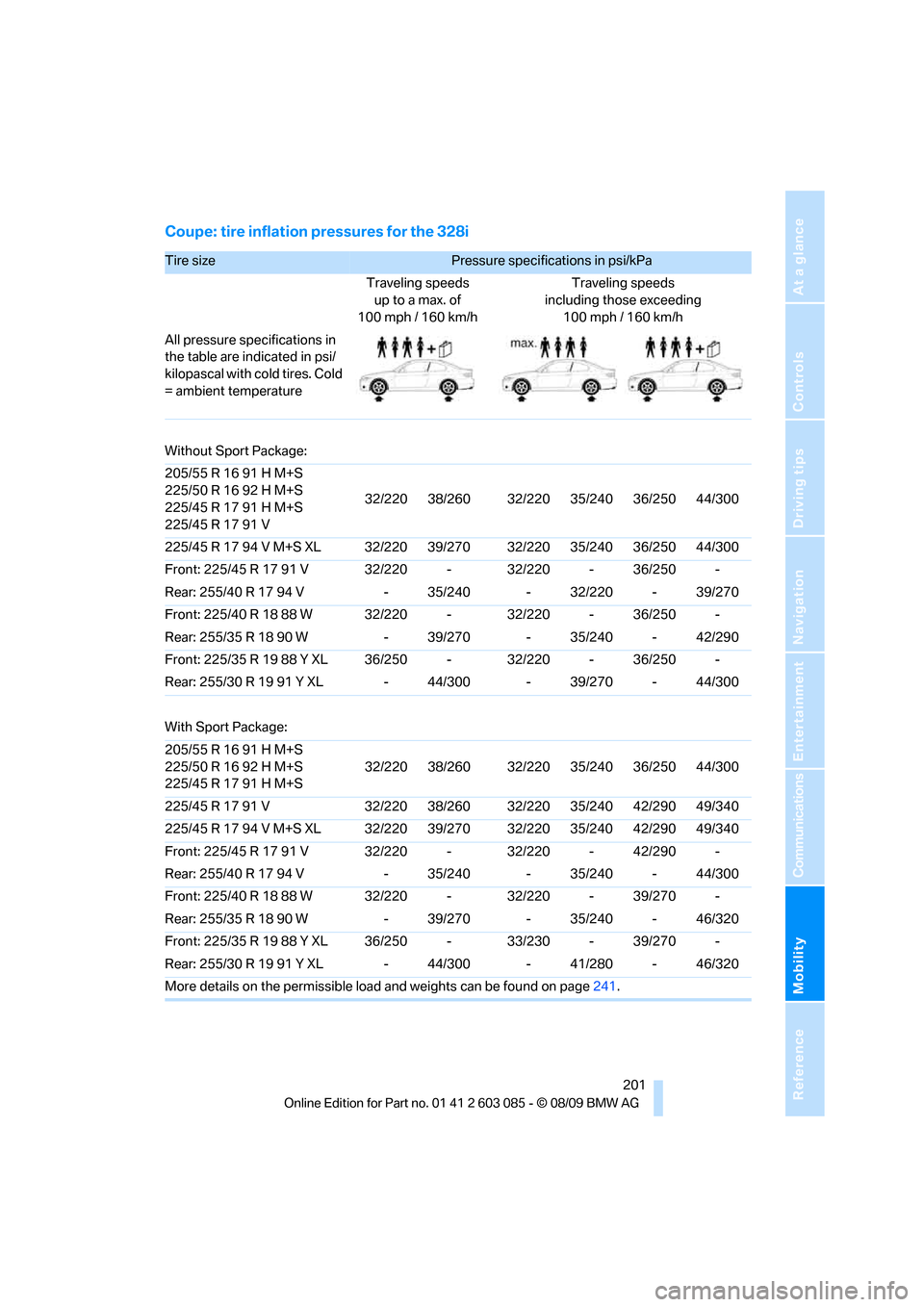
Mobility
201Reference
At a glance
Controls
Driving tips
Communications
Navigation
Entertainment
Coupe: tire inflation pressures for the 328i
Tire size Pressure specifications in psi/kPa
Traveling speeds
up to a max. of
100 mph / 160 km/hTraveling speeds
including those exceeding
100mph / 160km/h
All pressure specifications in
the table are indicated in psi/
kilopascal with cold tires. Cold
= ambient temperature
Without Sport Package:
205/55 R 16 91 H M+S
225/50 R 16 92 H M+S
225/45 R 17 91 H M+S
225/45 R 17 91 V32/220 38/260 32/220 35/240 36/250 44/300
225/45 R 17 94 V M+S XL 32/220 39/270 32/220 35/240 36/250 44/300
Front: 225/45 R 17 91 V 32/220 - 32/220 - 36/250 -
Rear: 255/40 R 17 94 V - 35/240 - 32/220 - 39/270
Front: 225/40 R 18 88 W 32/220 - 32/220 - 36/250 -
Rear: 255/35 R 18 90 W - 39/270 - 35/240 - 42/290
Front: 225/35 R 19 88 Y XL 36/250 - 32/220 - 36/250 -
Rear: 255/30 R 19 91 Y XL - 44/300 - 39/270 - 44/300
With Sport Package:
205/55 R 16 91 H M+S
225/50 R 16 92 H M+S
225/45 R 17 91 H M+S32/220 38/260 32/220 35/240 36/250 44/300
225/45 R 17 91 V 32/220 38/260 32/220 35/240 42/290 49/340
225/45 R 17 94 V M+S XL 32/220 39/270 32/220 35/240 42/290 49/340
Front: 225/45 R 17 91 V 32/220 - 32/220 - 42/290 -
Rear: 255/40 R 17 94 V - 35/240 - 35/240 - 44/300
Front: 225/40 R 18 88 W 32/220 - 32/220 - 39/270 -
Rear: 255/35 R 18 90 W - 39/270 - 35/240 - 46/320
Front: 225/35 R 19 88 Y XL 36/250 - 33/230 - 39/270 -
Rear: 255/30 R 19 91 Y XL - 44/300 - 41/280 - 46/320
More details on the permissible load and weights can be found on page241.
Page 204 of 266
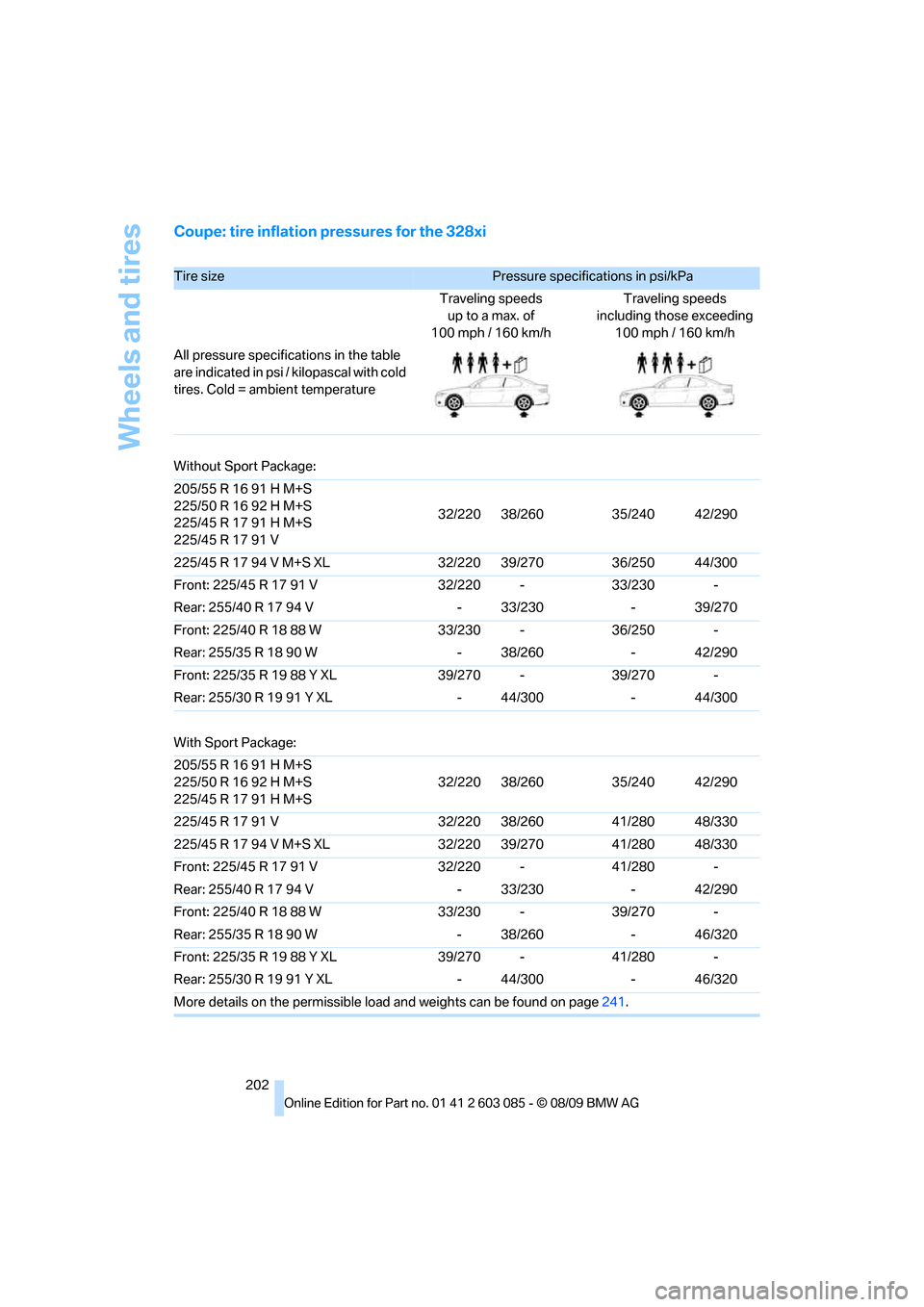
Wheels and tires
202
Coupe: tire inflation pressures for the 328xi
Tire size Pressure specifications in psi/kPa
Traveling speeds
up to a max. of
100mph / 160km/hTraveling speeds
including those exceeding
100 mph / 160 km/h
All pressure specifications in the table
are indicated in psi / kilopascal with cold
tires. Cold = ambient temperature
Without Sport Package:
205/55 R 16 91 H M+S
225/50 R 16 92 H M+S
225/45 R 17 91 H M+S
225/45 R 17 91 V32/220 38/260 35/240 42/290
225/45 R 17 94 V M+S XL 32/220 39/270 36/250 44/300
Front: 225/45 R 17 91 V 32/220 - 33/230 -
Rear: 255/40 R 17 94 V - 33/230 - 39/270
Front: 225/40 R 18 88 W 33/230 - 36/250 -
Rear: 255/35 R 18 90 W - 38/260 - 42/290
Front: 225/35 R 19 88 Y XL 39/270 - 39/270 -
Rear: 255/30 R 19 91 Y XL - 44/300 - 44/300
With Sport Package:
205/55 R 16 91 H M+S
225/50 R 16 92 H M+S
225/45 R 17 91 H M+S32/220 38/260 35/240 42/290
225/45 R 17 91 V 32/220 38/260 41/280 48/330
225/45 R 17 94 V M+S XL 32/220 39/270 41/280 48/330
Front: 225/45 R 17 91 V 32/220 - 41/280 -
Rear: 255/40 R 17 94 V - 33/230 - 42/290
Front: 225/40 R 18 88 W 33/230 - 39/270 -
Rear: 255/35 R 18 90 W - 38/260 - 46/320
Front: 225/35 R 19 88 Y XL 39/270 - 41/280 -
Rear: 255/30 R 19 91 Y XL - 44/300 - 46/320
More details on the permissible load and weights can be found on page241.
Page 205 of 266
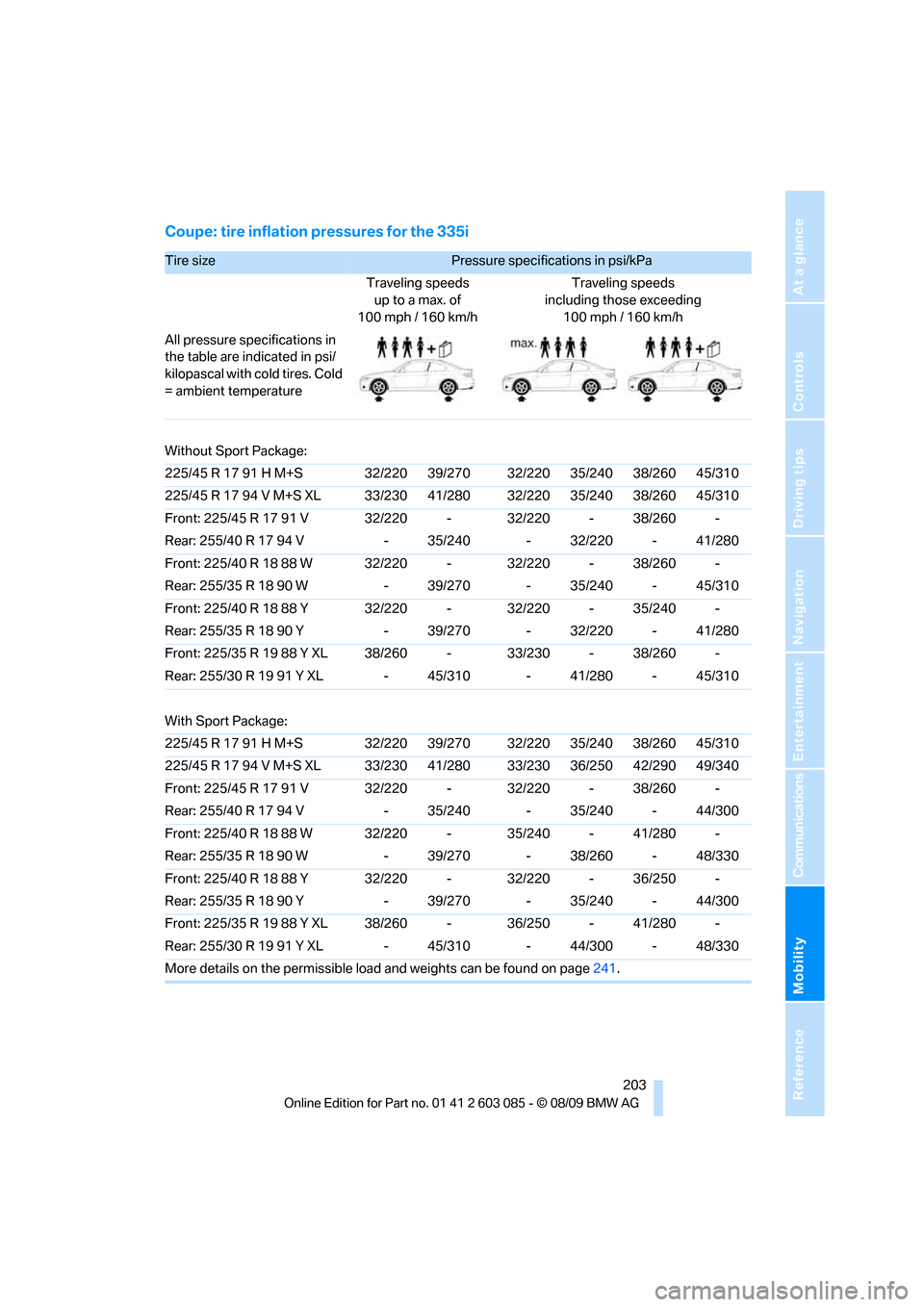
Mobility
203Reference
At a glance
Controls
Driving tips
Communications
Navigation
Entertainment
Coupe: tire inflation pressures for the 335i
Tire size Pressure specifications in psi/kPa
Traveling speeds
up to a max. of
100 mph / 160 km/hTraveling speeds
including those exceeding
100mph / 160km/h
All pressure specifications in
the table are indicated in psi/
kilopascal with cold tires. Cold
= ambient temperature
Without Sport Package:
225/45 R 17 91 H M+S 32/220 39/270 32/220 35/240 38/260 45/310
225/45 R 17 94 V M+S XL 33/230 41/280 32/220 35/240 38/260 45/310
Front: 225/45 R 17 91 V 32/220 - 32/220 - 38/260 -
Rear: 255/40 R 17 94 V - 35/240 - 32/220 - 41/280
Front: 225/40 R 18 88 W 32/220 - 32/220 - 38/260 -
Rear: 255/35 R 18 90 W - 39/270 - 35/240 - 45/310
Front: 225/40 R 18 88 Y 32/220 - 32/220 - 35/240 -
Rear: 255/35 R 18 90 Y - 39/270 - 32/220 - 41/280
Front: 225/35 R 19 88 Y XL 38/260 - 33/230 - 38/260 -
Rear: 255/30 R 19 91 Y XL - 45/310 - 41/280 - 45/310
With Sport Package:
225/45 R 17 91 H M+S 32/220 39/270 32/220 35/240 38/260 45/310
225/45 R 17 94 V M+S XL 33/230 41/280 33/230 36/250 42/290 49/340
Front: 225/45 R 17 91 V 32/220 - 32/220 - 38/260 -
Rear: 255/40 R 17 94 V - 35/240 - 35/240 - 44/300
Front: 225/40 R 18 88 W 32/220 - 35/240 - 41/280 -
Rear: 255/35 R 18 90 W - 39/270 - 38/260 - 48/330
Front: 225/40 R 18 88 Y 32/220 - 32/220 - 36/250 -
Rear: 255/35 R 18 90 Y - 39/270 - 35/240 - 44/300
Front: 225/35 R 19 88 Y XL 38/260 - 36/250 - 41/280 -
Rear: 255/30 R 19 91 Y XL - 45/310 - 44/300 - 48/330
More details on the permissible load and weights can be found on page241.
Page 206 of 266
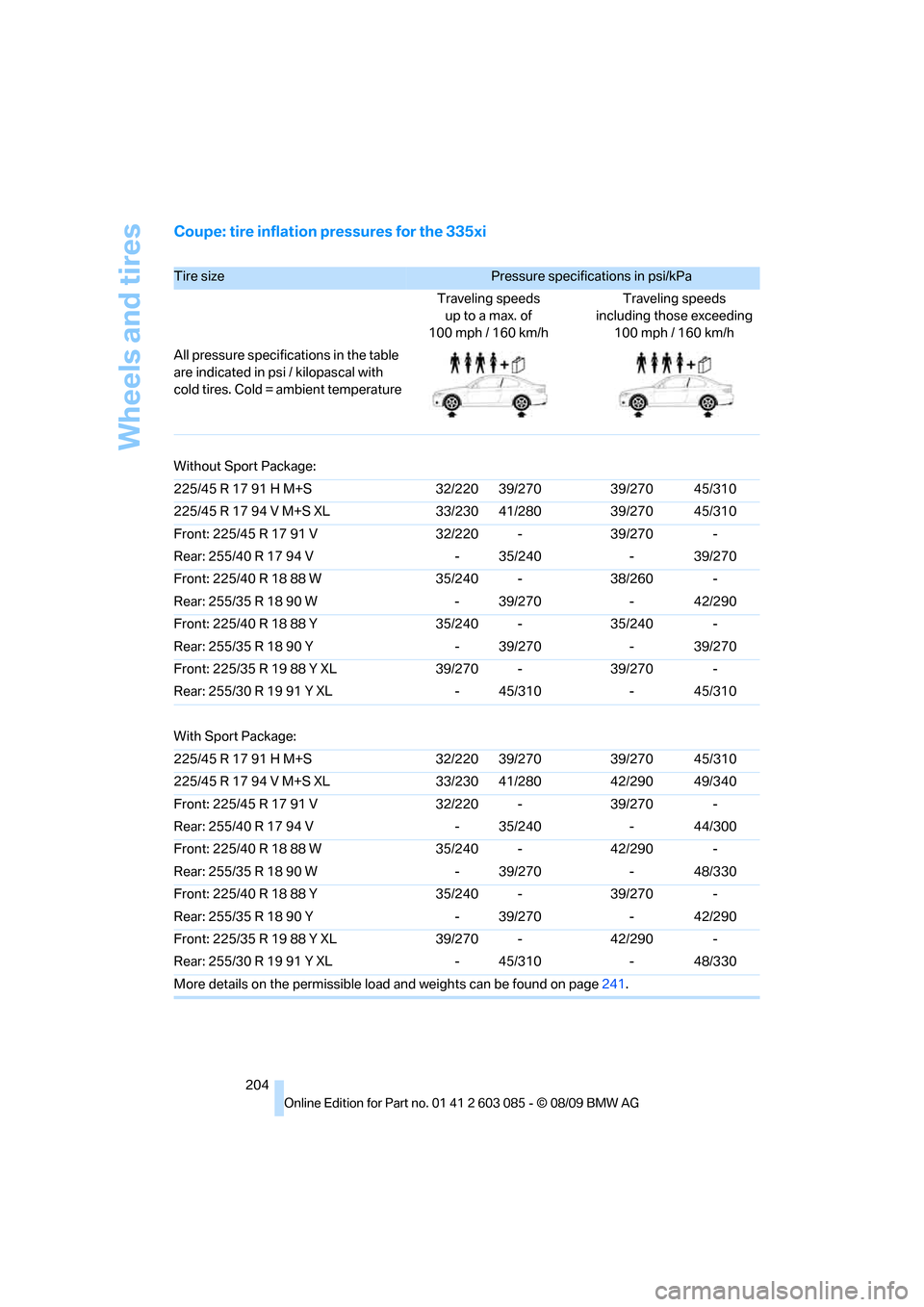
Wheels and tires
204
Coupe: tire inflation pressures for the 335xi
Tire size Pressure specifications in psi/kPa
Traveling speeds
up to a max. of
100mph / 160km/hTraveling speeds
including those exceeding
100 mph / 160 km/h
All pressure specifications in the table
are indicated in psi / kilopascal with
cold tires. Cold = ambient temperature
Without Sport Package:
225/45 R 17 91 H M+S 32/220 39/270 39/270 45/310
225/45 R 17 94 V M+S XL 33/230 41/280 39/270 45/310
Front: 225/45 R 17 91 V 32/220 - 39/270 -
Rear: 255/40 R 17 94 V - 35/240 - 39/270
Front: 225/40 R 18 88 W 35/240 - 38/260 -
Rear: 255/35 R 18 90 W - 39/270 - 42/290
Front: 225/40 R 18 88 Y 35/240 - 35/240 -
Rear: 255/35 R 18 90 Y - 39/270 - 39/270
Front: 225/35 R 19 88 Y XL 39/270 - 39/270 -
Rear: 255/30 R 19 91 Y XL - 45/310 - 45/310
With Sport Package:
225/45 R 17 91 H M+S 32/220 39/270 39/270 45/310
225/45 R 17 94 V M+S XL 33/230 41/280 42/290 49/340
Front: 225/45 R 17 91 V 32/220 - 39/270 -
Rear: 255/40 R 17 94 V - 35/240 - 44/300
Front: 225/40 R 18 88 W 35/240 - 42/290 -
Rear: 255/35 R 18 90 W - 39/270 - 48/330
Front: 225/40 R 18 88 Y 35/240 - 39/270 -
Rear: 255/35 R 18 90 Y - 39/270 - 42/290
Front: 225/35 R 19 88 Y XL 39/270 - 42/290 -
Rear: 255/30 R 19 91 Y XL - 45/310 - 48/330
More details on the permissible load and weights can be found on page241.
Page 207 of 266
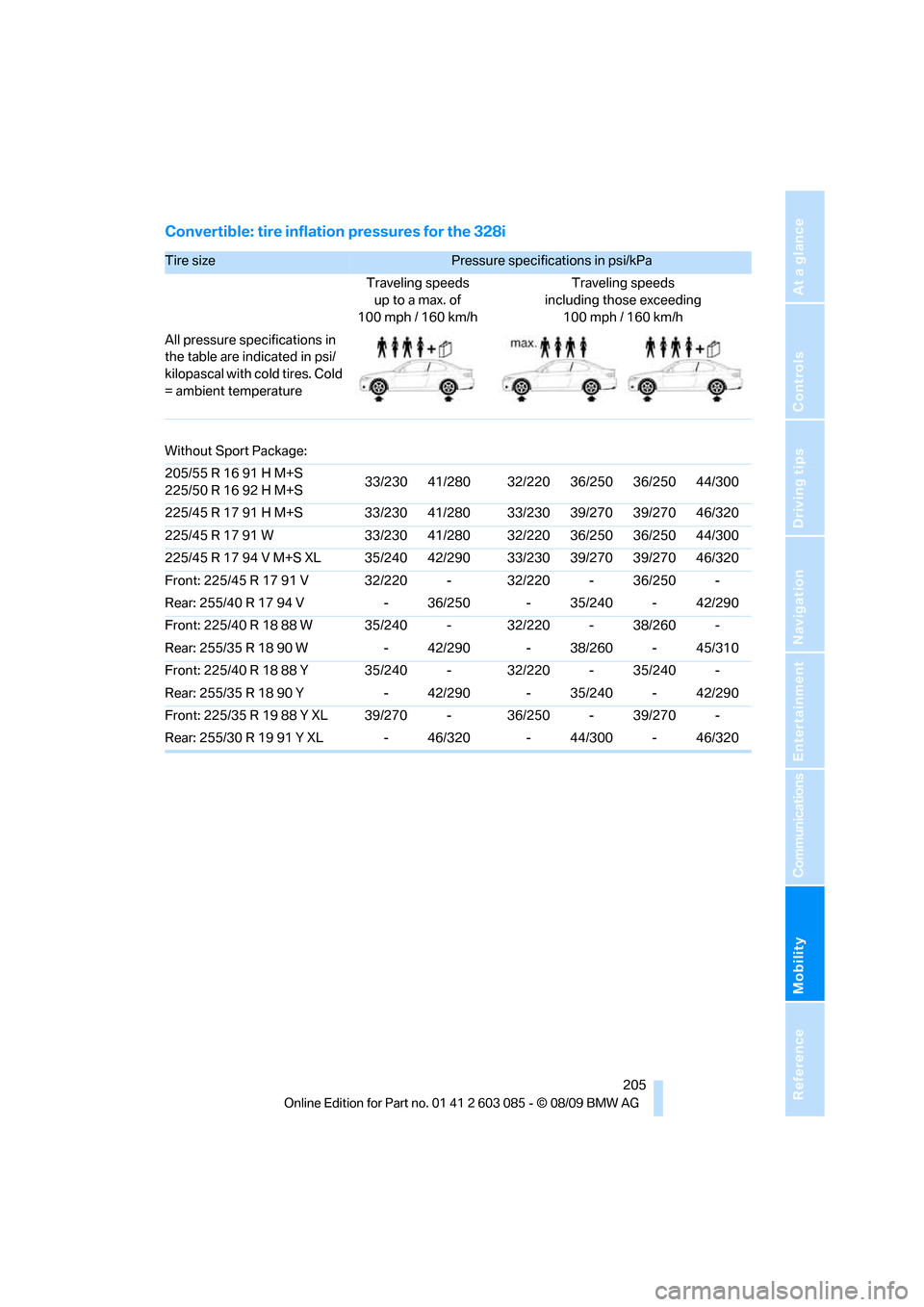
Mobility
205Reference
At a glance
Controls
Driving tips
Communications
Navigation
Entertainment
Convertible: tire inflation pressures for the 328i
Tire size Pressure specifications in psi/kPa
Traveling speeds
up to a max. of
100 mph / 160 km/hTraveling speeds
including those exceeding
100mph / 160km/h
All pressure specifications in
the table are indicated in psi/
kilopascal with cold tires. Cold
= ambient temperature
Without Sport Package:
205/55 R 16 91 H M+S
225/50 R 16 92 H M+S33/230 41/280 32/220 36/250 36/250 44/300
225/45 R 17 91 H M+S 33/230 41/280 33/230 39/270 39/270 46/320
225/45 R 17 91 W 33/230 41/280 32/220 36/250 36/250 44/300
225/45 R 17 94 V M+S XL 35/240 42/290 33/230 39/270 39/270 46/320
Front: 225/45 R 17 91 V 32/220 - 32/220 - 36/250 -
Rear: 255/40 R 17 94 V - 36/250 - 35/240 - 42/290
Front: 225/40 R 18 88 W 35/240 - 32/220 - 38/260 -
Rear: 255/35 R 18 90 W - 42/290 - 38/260 - 45/310
Front: 225/40 R 18 88 Y 35/240 - 32/220 - 35/240 -
Rear: 255/35 R 18 90 Y - 42/290 - 35/240 - 42/290
Front: 225/35 R 19 88 Y XL 39/270 - 36/250 - 39/270 -
Rear: 255/30 R 19 91 Y XL - 46/320 - 44/300 - 46/320